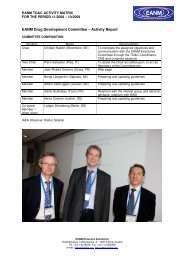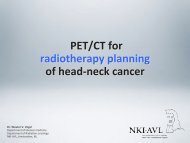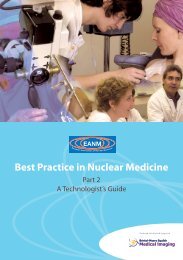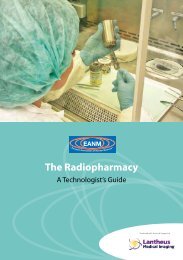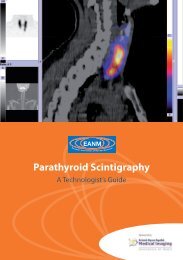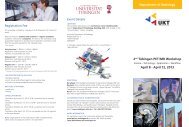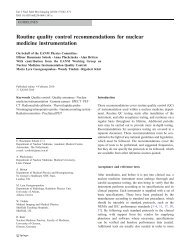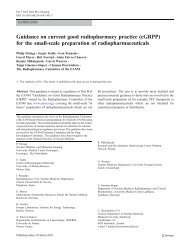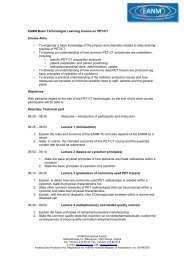Parathyroid Scintigraphy - European Association of Nuclear Medicine
Parathyroid Scintigraphy - European Association of Nuclear Medicine
Parathyroid Scintigraphy - European Association of Nuclear Medicine
Create successful ePaper yourself
Turn your PDF publications into a flip-book with our unique Google optimized e-Paper software.
cyclotron produced. Its uptake reflects amino<br />
acid reflux into stimulated parathyroid tissue<br />
(Otto et al. 2004; Beggs and Hain 2005). Uptake<br />
in inflammatory conditions may pose<br />
a problem and should be considered when<br />
interpreting images. The typical radioactivity<br />
dose ranges between 240 and 820 MBq, with<br />
an average intravenous dose <strong>of</strong> 400 MBq.<br />
18 F-FDG<br />
18 F-FDG has a half-life <strong>of</strong> 110 min and is cyclotron<br />
produced. 18 F-FDG allows glucose<br />
metabolism to be assessed and evaluated<br />
using PET. There is differential concentration<br />
<strong>of</strong> FDG in abnormal parathyroid tissue<br />
and this difference is used to demonstrate<br />
the abnormal gland. FDG also accumulates<br />
in other malignant and benign tissues, and<br />
in inflamed or infected tissue; this potentially<br />
limits its usefulness. The typical intravenous<br />
dose is 400 MBq.<br />
Radiopharmaceutical features<br />
Multiple radiopharmaceuticals have been<br />
described for the detection <strong>of</strong> parathyroid lesions.<br />
Thallium, sestamibi and tetr<strong>of</strong>osmin are<br />
the three most commonly used (Ahuja et al.<br />
2004). All these agents were originally developed<br />
for cardiac scanning. In the 1980s, 201 Tl<br />
was the most commonly used agent, but it<br />
has a longer half-life and delivers a higher radiation<br />
dose to the patient (Kettle 2002). Consequently,<br />
201 Tl is no longer commonly used,<br />
and most recent literature refers to the use <strong>of</strong><br />
99m Tc-sestamibi. However, for the subtraction<br />
1<br />
method it is probable that each radiopharmaceutical<br />
would provide the same diagnostic<br />
information (Kettle 2002).<br />
Subtraction agents<br />
Thyroid-specific imaging with 123 I or 99m Tcpertechnetate<br />
may be employed using a subtraction<br />
method to differentiate parathyroid<br />
from thyroid activity (Clark 2005).<br />
The two main agents used for imaging the<br />
thyroid are 123 I (sodium iodide) and 99m Tcpertechnetate.<br />
There is a slight preference for<br />
the use <strong>of</strong> 123 I, as it is organified and therefore<br />
provides a stable image. The pertechnetate<br />
washes out from the thyroid gland with time,<br />
and if there is some delay in imaging there<br />
may be a reduction in the quality <strong>of</strong> the<br />
thyroid image (Kettle 2002). However, both<br />
agents may be affected if the patient is taking<br />
thyroxine or anti-thyroid medications or has<br />
recently received iodine contrast agents.<br />
Thyroid-specific radiopharmaceuticals may<br />
aid delineation <strong>of</strong> the thyroid parenchyma if<br />
required after dual-phase imaging. This may<br />
be helpful as a second-line “visual subtraction”<br />
procedure when no parathyroid adenoma is<br />
visible on dual-phase parathyroid imaging<br />
(Clark 2005).<br />
Activities given for imaging the thyroid<br />
and parathyroid glands are as follows: 99m Tc<br />
pertechnetate, 80 MBq; 123 I, 40 MBq; 201 Tl,<br />
80 MBq; 99m Tc-sestamibi, 900 MBq. If a 99m Tc-






